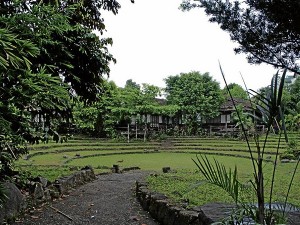Artists’ lost haven rediscovered

SERVING as a gathering place, this expansive yet shallow amphitheater is the Artists’ Villages’ centerpiece. Photo by Charles E. Buban
(First of two parts)
The fact that it was the late national artist for architecture, Leandro V. Locsin, who was behind the creation of this place should already elicit awe and wonder.
“Unknown to many, including those in the arts and culture community, the Artists’ Village has been a haven to a number of artists, theologians and scholars from all over the world,” explains Dr. Francisco Feliciano, composer and former resident conductor of the Philippine Philharmonic Orchestra who helped found the Artists’ Village also known as Sambalikhaan.
Inaugurated in 1992, the Artists’ Village was masterplanned to enhance an artist’s creativity: nine traditional Filipino houses built on stilts stand on the edges of this property generously filled with fruit trees, shrubberies and tall bamboo plants.
An expansive yet shallow amphitheater—that serves as a gathering place—lies in the middle of this one-and-a-half-hectare property owned by the Episcopal Church in the Philippines (located a few hundred meters behind Trinity University of Asia in Quezon City and bounded by Diliman Creek).
Well-sheltered
Being nestled deep in the property of the Episcopal Church in the Philippines and the fact that it is surrounded by mature trees, bestow the Artists’ Village with a quiet and secluded environment.
“Here, one is transported back to an older, more simple time. The Artists’ Village creates a simple, rustic ambiance,” describes Ymmanwel Rico Provinio, a journalist-artist who lives in one of the houses.
Provinio says Locsin designed each house to be simple as well as representative to what a traditional Filipino home should be—clay tiles for the roof, Capiz shells on windows, hardwood as stilts and on the walls and flooring.
Connecting a number of these houses is an elevated concrete walkway (there was a time when this was made of wood and bamboo) while the rest are accessible via stone walkways quarried from Vigan, Ilocos Sur.
Ifugao-inspired houses

FELICIANO, lounging in one of the resident artist’s houses (now occupied by Provinio) explains that the Artists’ Village is a place designed to enhance one’s creativity. Photo by Charles E. Buban
Provinio adds that since most of the artists who designed and built the place all hail from the provinces of the Cordillera mountain range, the structures that were put in place at the Artists’ Village were all inspired by the traditional architecture found in Ifugao and the Mountain Province: the stilt houses from the “bale” of Ifugao, and the terraced performance circle from the rice terraces of Banaue and Sagada.
Such designs not only preserve the aesthetic value of the place but these stilts also protect residents from rats and against inclement weather.
“Locsin should be commended for his foresight to use stilts to elevate the houses because when Tropical Storm ‘Ondoy’ struck in 2009, the water from the creek rose so high it reached the second flight of the stairs leading to the loft area, which is already over 3 meters from the ground,” Provinio relates.
Upon entering one of the houses one would be reminded of being inside a traditional bahay kubo: there’s the bulwagan, which is a one, large, open, multipurpose room for receiving guests, a living quarter, or in the case of Provinio, his painting studio. Each front has a balcony which could be accessed via a sliding door with header of wood and Capiz finish.
“I just open my windows, look around and in a short while, I am already inspired to start another round of painting,” Provinio says.
While Locsin took care of designing the houses, Feliciano on the other hand, did some of the the landscaping of the Artists’ Village.
“The amphitheater serves as a focal point for artists, musicians, writers and liturgists. Here we are able to pursue our creative work as expressions of our faith. Here we have a creative environment where the arts are respected as an important aspect of health and healing,” Provinio explains.
Resort-style oasis
In fact, the late Locsin intended to have a resort-style oasis that he even planned a 3-meter deep fishing lagoon in the northeast corner of the property to complete the restful ambiance of the Artists’ Village. “But that part has to be momentarily abandoned, especially since the water could be a source of dengue outbreak and the fact that someone might get drowned,” Provinio says.
As the place observes its 20th year, the Episcopal Church in the Philippines is hoping to revive the glory of the Artists’ Village. “It has been sometime since this place saw a lot of residents. Most of the houses are now vacant because they all need to be repaired,” reports Provinio who believes that the sanctuary is one place that deserves much attention because it’s the only one of its kind located in Metro Manila.
The closest would be the National Arts Center in Mount Makiling, Los Baños, Laguna.
“Emerging and established artists needs a haven and the Artists’ Village is one perfect place that pays homage to the vibrant arts and culture of the Philippines,” Provinio says. (Next: Reviving artists’ haven)














